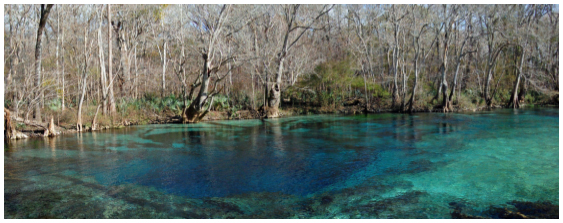
Spring sampling helps protect resources
Since 2001 the Northwest Florida Water Management District has helped protect the region’s springs by collecting data, conducting spring inventories and monitoring water quality and distribution. This is part of the statewide Florida Springs Initiative, funded by the Florida Legislature, administered by the Florida Department of Environmental Protection. Some of the measurements taken by the District are nitrate concentrations, and they tell an important story.

“The nitrate load discharged from Jackson Blue Spring represents an economic loss to farmers, growers and homeowners,” said Kris Barrios, Director, Field Services Section.
“Instead of being taken up by plants, these nutrients are carried into the aquifer and eventually discharge to Merritt’s Mill Pond. We calculate 80 tons of nitrogen lost every year at $200-400 per ton.”
Fertilizer sales in Jackson County dropped to 1000 tons a year from 3000 in the mid-1990s when farmers realized they could save money and the environment by using less fertilizer. Nitrate concentrations have in- creased from about 0.3 mg/L in 1960 to the current concentration of about 3.5 mg/L.
“The cost is greater than just to the property owner,” Barrios added. “It lowers the quality of natural habitat and increases the probability of algal blooms.”
Any water that seeps into the ground in the Blue Spring contribution zone — about 177 square miles of agricultural land—is destined for the spring. “It’s like a free hot dog in
every glass,” said Barrios . “At 3.5 milligrams of nitrate per liter (mg/L), there’s enough to equal the nitrites in an average hot dog for every 16 oz. glass of spring water.”
Jackson County has at least 68 springs documented by a District inventory, he added, the largest number of any county in the state. Blue Spring is a first magnitude spring, discharging an average of about 76 million gallons a day, and is the head spring of Merritt’s Mill pond.
Five other springs rise in the pond – Shangri La, Hole-in-the Wall, Twin Caves, Gator Hole and Heidi Hole. Nitrate concentrations in this group is elevated as well, ranging
from about 2 mg/L to 3.6 mg/L. All show effects of fertilizer runoff.
“All that lost fertilizer is doing its job,” Barrios said. ―But it’s doing it in Merritt’s
Mill Pond, which causes algae growth and reduces the quality of recreation and eco- system.”
Wakulla Spring, with a current concentration of 0.5 mg/L, ranks third in nitrate levels among the District’s first magnitude springs. However, Wakulla’s levels have decreased from as high as 1.6 mg/L during the late 1980s. This decrease may be due in part to improvements in the City of Tallahassee’s wastewater treatment. Dilution
due to flow also plays a significant role.
Cypress Spring, Washington County, is among the District’s most pristine springs, said Patrick Casey, Field Representative Specialist. Nitrate concentrations average 0.36 mg/L.
“Visibility is at least 100 feet and there’s very little algae growing on anything. All the invasive plants are in check,” Casey said.
Cypress Spring is blue because it’s issuing clear, filtered ground water,” added Barrios. “We haven’t documented any sinkholes in the area that are contributing surface runoff.”
Morrison Spring was recently restored with dive platforms, gazebo, walkways, restrooms and pervious parking lot, an effort to reduce contaminated runoff to the spring.
In addition to nitrate levels, other measurements taken are temperature (with median values of about 20 Celsius or 68 Fahrenheit), dissolved oxygen concentration (which tends to decrease with longer residence in the aquifer), pH (which at about 7.7 tends
to be well buffered and reflect the mineralized, alkaline ground water of the Floridan Aquifer), specific conductivity (which measures dissolved mineral content and tends to be higher when not influenced by rain/surface water).
Photos taken during springs monitoring by Casey reveal a bluer cast in Jackson Blue Spring and a greener cast in Wakulla Spring. Casey said it had just rained and the water was more tannic at Wakulla Spring when he sampled it on June 20.
Barrios noted that the tannic content may also be higher because of higher – and increasing—flows to Wakulla Spring.
Bluegill, bass and shiners are common fresh water companions while sampling District springs, Casey said. District lab technicians snorkel all springs of the District except those at Merritt’s Mill Pond, which must be dived since expert cave divers have placed tubing deep inside the cave. District technicians are certified open water divers, meaning they don’t swim into cave openings, but they must retrieve the tubing, purge it and take immediate water quality readings.
The District monitors first magnitude springs for water quality, distribution and delineation of springsheds. They produce a minimum 64.6 million gallons a day (100 cubic feet/second). And include St. Marks Rise, Wakulla Spring, Spring Creek Group, Jackson Blue Spring and Gainer Springs Group.
Story courtesy Northwest Florida Water Management District. For more information, go to http://www.nwfwmd.state.fl.us/

Armida Foret
September 6, 2011Awesome informations it is actually. My sis has been waiting for this tips. Thanks=)